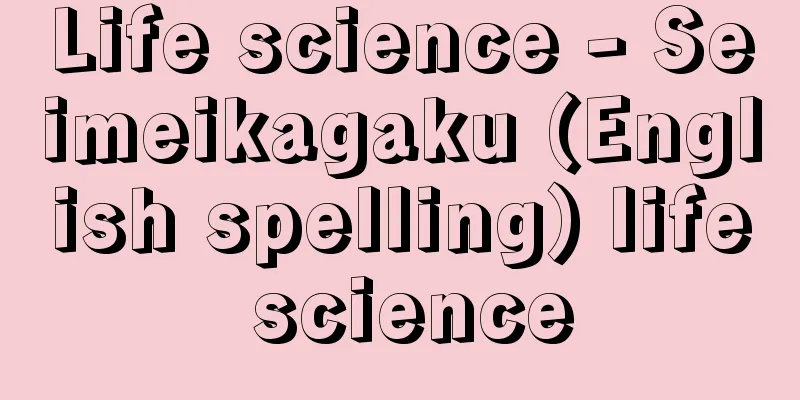Life science - Seimeikagaku (English spelling) life science

|
It refers to a comprehensive academic field developed since the 1970s that aims to elucidate the phenomenon of life, understand human beings, and develop science, technology, and social systems based on that understanding. [Keiko Nakamura] Background of the birth of life scienceIn the early 1970s, a new field called life science was born in the United States and in Japan. In the 1960s, science and technology in the United States had placed emphasis on space development, but in the 1970s, there was a demand to turn to areas closer to daily life. One area that drew attention was medicine. President Nixon set the goal of fighting cancer. Since cooperation between biology and medicine is essential to clarifying the cause of disease and linking it to prevention and treatment, he combined biology and medicine into life science as an item in the national research budget. Meanwhile, in Japan, Fujio Egami (then a professor at the University of Tokyo) conceived of life sciences at the same time. While advances in science and technology were making our lives more affluent, environmental problems were beginning to become evident, and it was recognized that we needed to explore how to live on a finite planet. As a result of biology, it became clear that all living things on Earth are based on DNA (deoxyribonucleic acid), including humans. However, if air and water pollution and deforestation continue, we cannot see a bright future for humanity. We need to build society from the perspective of humans as one of the living creatures, and advance science and technology based on an understanding of living things. Life sciences is a comprehensive academic field that aims to elucidate the phenomenon of life, understand humans, and develop science, technology, and social systems based on that understanding. [Keiko Nakamura] Development of Life Sciences(1) Understanding the phenomenon of life With the use of recombinant DNA technology and base sequence analysis technology developed in the late 1970s, research on cells, genetics, development, immunity, cancer, the brain and nerves, etc., has progressed rapidly. In the midst of this, the Human Genome Project, which aims to analyze the entire base sequence of human DNA, was underway, and decoding was completed in 2003. The current theme is how to proceed from this point onwards to elucidate the phenomenon of life. (2) The birth of biotechnology Using recombinant DNA technology, it became possible to manufacture drugs such as insulin, which are polymeric substances originally produced by living organisms and difficult to produce industrially, and to produce recombinant DNA crops (for example, potatoes, soybeans, corn, and tomatoes), giving birth to the new field of biotechnology, which was met with great expectations. However, only a limited number of drugs were produced, and it was difficult to gain public understanding of the safety of recombinant DNA crops, so there was no significant industrial development. In the 21st century, with the decoding of the human genome (as well as the decoding of various other bacteria, yeast, and rice), hopes for drug discovery and breeding have risen once again, but at this point it is difficult to make a clear prediction of future developments. (3) Life sciences becoming biomedicine With such advances in science and technology, the combination of biology and medicine has become commonplace in the United States, and the term biomedicine has become commonplace, with the term life sciences rarely being used. [Keiko Nakamura] Problems in Life SciencesWith the completion of the human genome and growing expectations for biomedicine, the 21st century has seen renewed attention on life science as a field that develops cutting-edge technologies to revitalize the economy. When it was first proposed, the idea was to deepen our understanding of humans as living creatures and use that as a basis for developing new social systems and science and technology, but now the important task has become obtaining patents and launching venture businesses in the financial economy. Of course, industrial development of pharmaceuticals, medical care, seeds, food, and other fields based on DNA research is important, but life science has no meaning unless it leads to the creation of a society in which humans, as living creatures, can live comfortably. This is an important time to make a decision in considering the shape of society in the 21st century. [Keiko Nakamura] From Life Science to BiohistoryLet us now turn our attention to the characteristics of living things. Conventional life science has placed living organisms in a mechanistic worldview and attempted to elucidate them using the methods of physical science. However, living organisms are diverse, complex, ambiguous, hierarchical, and ambiguous, and because they are the product of history (nearly 4 billion years old) and an open system, they are connected to their environment. Such an existence cannot be reduced to laws or formulas, and can only be told through words. It is believed that the genome has a structure that tells such a story. Therefore, it is essential to understand cells, individuals, species, and ecosystems using the genome as a unit, and to assemble new knowledge that understands the relationships between them. This is aptly called "Biohistory," and will create a bio-logical worldview. [Keiko Nakamura] Knowledge that supports the 21st centuryLife science was not born simply as a branch of science, but had the intention of changing society's values from a mechanistic to a vitalistic worldview, and of creating a life in which humans, as living beings, can live together with other living things. However, it cannot be said that life science has been successful in this regard. Reasons for this include that it dealt with living things within the paradigm of physical science, that it limited its usefulness to society to the economy and rushed too much into science, technology, and industry, that it separated academia from everyday life and did not value sensitivities toward living things, and that it did not engage in discussions about values. In terms of daily life, we are required to develop technology and create social systems that emphasize four areas: food (agriculture, forestry, and fisheries), health (medical care and welfare), the environment, and education (mind). However, today's society, which aims to survive in a competitive society under a financial economy, does not value these basic elements of life. For example, even though somatic cell cloning of mammals has become possible, there are people who call for the birth of human clones. This was born out of a mindset in which external fertilization has become commonplace and people can realize their desires even by using other people's reproductive cells and uteruses. When we think deeply about life, we should come to the answer that we also need to suppress our desires. Once again, in order to enable all people to live truly rich lives on this finite earth, the theme of the 21st century will be to shift from machines and fire, which symbolize the 20th century, to life and water. [Keiko Nakamura] Reading Biohistory in the Microcosm, by Nakamura Keiko (1990, Mita Publishing) ▽ From Life Science to Biohistory, by Nakamura Keiko (1991, Shogakukan) ▽ Life Science Document Collection, edited by the Life Science Document Collection Editorial Committee (1997, University of Tokyo Press) ▽ From the Window of Biohistory, by Nakamura Keiko (1998, Shogakukan) ▽ The World of Biohistory, by Nakamura Keiko (2000, NHK Library) ▽ The Current State of Science for Humans and Living Things, by Okada Setsuto (2001, Iwanami Shoten) ▽ New Plant Life Science, edited by Omori Masayuki et al., Yanai Tetsuichi et al. (2001, Kodansha) ▽ Life Science and Ethics: Thinking about Life in the 21st Century, edited by the Kwansei Gakuin University Center for Christian and Cultural Studies (2001, Kwansei Gakuin University Press) ▽ "The Future of Post-Genome: New Life Sciences and Biobusiness" by Miyaki Koichi (2001, Kadokawa Shoten)" ▽ "Introduction to Modern Life Sciences" by Kobiga Masataka and Nakajima Yoko (2001, Keio University Press) " ▽ "Development and Law of Life Sciences: A Draft of Bioethics Law" edited by National Institute for Advanced Industrial Science and Technology and Kawai Ken (2001, Yuhikaku)" ▽ "Gene and Genome" by Matsubara Kenichi (2002, Iwanami Shoten)" ▽ "Talking about the Future of Life" by Honjo Tasuku and Nakamura Keiko (2002, Iwanami Shoten)" ▽ "Reproductive Revolution and Law: Development and Ethics of Life Sciences" edited by National Institute for Advanced Industrial Science and Technology and written by Fujikawa Tadahiro (2002, Nihon Keizai Hyoronsha)" ▽ "University Basic Biology for Students of Life Sciences" by Shiokawa Koichiro (2002, Kyoritsu Shuppan)" ▽ "Modern and Contemporary History of Life Sciences" edited by Hirono Yoshiyuki, Ichinokawa Yoshitaka, and Hayashi Mari (2002, Keiso Shobo) " ▽ "Fundamentals of Life Sciences by Nakamura Un (2003, Kagaku Dojin)" ▽ "Life Sciences and What is 'Life'? - An Invitation to Life Sciences" by Nakamura Keiko (Kodansha Academic Library)" ▽ "Notes from a Life Scientist by Nakamura Keiko (Iwanami Gendai Bunko)" ▽ "Life Science of Proteins - A Key Player in the Post-Genome Era" by Ikeuchi Toshihiko (Chuko Shinsho) [References] | | | | | | | | |Source: Shogakukan Encyclopedia Nipponica About Encyclopedia Nipponica Information | Legend |
|
1970年代以降に進められた、生命現象の解明、人間の理解とそれを基本にした科学技術や社会システムの開発を目ざした総合的な学問をいう。 [中村桂子] 生命科学誕生の背景1970年代初め、アメリカでライフサイエンス、日本で生命科学という新分野が誕生した。アメリカでは、1960年代に宇宙開発に重点を置いていた科学・科学技術に対し、1970年代に入って、より生活に近い分野に目を向けることが求められた。そこで注目されたのが、医療。大統領ニクソンは、癌(がん)との闘いを目標とした。病因を明らかにし、予防・治療につなげるには、生物学と医学の連携が不可欠であるということで、国の研究予算の項目として生物学と医学をまとめてライフサイエンスとしたのである。 一方、同じころ日本では、江上不二夫(ふじお)(当時東京大学教授)が、生命科学を構想した。科学技術の進展により生活が豊かになる反面、環境問題が顕在化し始め、有限な地球のなかでの生き方を探る必要が認識された時代である。生物学の成果として地球上の生物はすべてDNA(デオキシリボ核酸)を基本とする仲間であり、そのなかに人間も含まれることが明らかになったなかで、大気や水の汚染、森林破壊が進むとすれば、人類の明るい未来はみえない。生きものの一つとしての人間という視点から社会を組み立て、科学技術も生物の理解を基本にして進める必要がある。このような考え方で生命現象の解明、人間の理解とそれを基本にした科学技術や社会システムの開発を目ざした総合的な学問が生命科学である。 [中村桂子] 生命科学の展開(1)生命現象の理解 1970年代後半に開発された組換えDNA技術と塩基配列解析技術の活用により、細胞、遺伝、発生、免疫、癌、脳神経などの研究は急速に進展した。そのなかでヒトがもつDNAのすべての塩基配列解析を目ざすヒトゲノムプロジェクトが進められ、2003年(平成15)には解読が完了した。ここから改めて生命現象の解明をどう進めていくかが現在のテーマである。 (2)バイオテクノロジーの誕生 組換えDNA技術を用いて、インスリンなど、本来生物がつくりだす高分子物質で、工業生産はむずかしかった薬品の製造や組換えDNA作物(たとえば、ジャガイモ、ダイズ、トウモロコシ、トマト)の生産などが可能となり、バイオテクノロジーという新分野が誕生し、大いに期待された。しかし、薬品は限られたものしか生まれず、組換えDNA作物も安全性について市民の理解が得にくいなど、産業的には大きな展開はみられなかった。21世紀に入り、ヒトゲノム解読(その他各種細菌、酵母、イネなども解読)により、創薬や品種改良への期待がふたたび高まっているが、今後の展開の明確な予測は、現時点ではむずかしい。 (3)ライフサイエンスは生物医学へ このような科学と技術の進展でアメリカでは生物学と医学の合体が当然のこととなり、生物医学Biomedicineということばが日常語となって、ライフサイエンスはほとんど使われなくなっている。 [中村桂子] 生命科学の問題点ヒトゲノムの解読完了、生物医学への期待の増大などで、21世紀に入って改めて、生命科学が、経済の活性化のための最先端技術を開発する分野として注目され始めた。当初提唱されたときには、生きものの一つとしての人間の理解を深め、それを基本に新しい社会システムや科学技術の開発をするという理念があったのに、いまや金融経済のなかで特許を取得し、ベンチャービジネスを立ち上げることが重要な作業になっている。もちろん、DNA研究を基盤にした薬品、医療、種苗、食品などの産業開発は重要だが、それが本当に生きものとしての人間の暮らしやすい社会づくりにつながらなければ、生命科学の意味がない。21世紀の社会のあり方を考えるうえで重要な選択のときである。 [中村桂子] 生命科学から生命誌へここで、生きものの特徴に目を向けてみよう。従来の生命科学は、生物を機械論的世界観のなかに置き、物理科学の方法で解明しようとしてきた。しかし、生命体は、多様性、複雑性、曖昧(あいまい)性、階層性、多義性をもち、しかも歴史の産物(40億年近い歴史)で開放系であるために環境とつながっている。このような存在は、法則・数式に還元できるものではなく、ことばで語るほかない。ゲノムには、そのような物語りを語る構造があると思われる。そこで、ゲノムを単位として細胞、個体、種、生態系をそれぞれ理解するとともに、お互いの関係を知る新しい知を組み立てていくことが不可欠である。これは「生命誌Biohistory」とよぶのがふさわしく、生命論的世界観をつくりだすものとなるだろう。 [中村桂子] 21世紀を支える知を生命科学は、単なる科学の一分野として生まれたのではなく、社会の価値観を機械論から生命論的世界観に変え、生きものとしての人間が、他の生きものとともに暮らす生活をつくりあげようという意図をもっていた。しかし、生命科学は、それに成功したとはいえない。理由は、物理科学のパラダイムのなかで生きものを扱ったこと、社会に役だつことを経済に限定して科学技術や産業に走りすぎたこと、学問と日常とを分離して生きものに対する感性を大切にしなかったこと、価値観についての議論をしなかったこと、などがあげられる。 日常生活に関しては、食(農林水産業)、健康(医療、福祉)、環境、教育(心)の四つを重視した技術開発や社会システムづくりをすることが求められている。ところが、金融経済の下での競争社会に勝ち残ることを目標にしている現在の社会は、このような生活の基本を大切にしていない。たとえば、哺乳(ほにゅう)類での体細胞クローンが可能になったところで、ヒトクローンの誕生を求める人がいる。これは、対外受精が日常化し、他人の生殖細胞や子宮を用いてでも自分の願望を実現することが当然という考え方のなかで生まれたものである。生きることについて深く考えたとき、願望の抑制も必要という答えが出るはずだ。改めて、有限な地球のなかで、すべての人が真の豊かな生活を送れるようにするには、20世紀を象徴する機械と火に対して生命と水へと移行するのが21世紀のテーマになるだろう。 [中村桂子] 『中村桂子著『ミクロコスモスに生命誌をよむ』(1990・三田出版会)』▽『中村桂子著『生命科学から生命誌へ』(1991・小学館)』▽『生命科学資料集編集委員会編『生命科学資料集』(1997・東京大学出版会)』▽『中村桂子著『生命誌の窓から』(1998・小学館)』▽『中村桂子著『生命誌の世界』(2000・NHKライブラリー)』▽『岡田節人著『ヒトと生きものたちの科学のいま』(2001・岩波書店)』▽『大森正之ほか編著、矢内徹一ほか著『新しい植物生命科学』(2001・講談社)』▽『関西学院大学キリスト教と文化研究センター編著『生命科学と倫理――21世紀のいのちを考える』(2001・関西学院大学出版会)』▽『宮木幸一著『ポストゲノムのゆくえ――新しい生命科学とバイオビジネス』(2001・角川書店)』▽『小比賀正敬・中島陽子著『現代生命科学入門』(2001・慶応義塾大学出版会)』▽『総合研究開発機構・川井健編『生命科学の発展と法――生命倫理法試案』(2001・有斐閣)』▽『松原謙一著『遺伝子とゲノム』(2002・岩波書店)』▽『本庶佑・中村桂子著『生命の未来を語る』(2002・岩波書店)』▽『総合研究開発機構編、藤川忠宏著『生殖革命と法――生命科学の発展と倫理』(2002・日本経済評論社)』▽『塩川光一郎著『生命科学を学ぶ人のための大学基礎生物学』(2002・共立出版)』▽『広野喜幸・市野川容孝・林真理編『生命科学の近現代史』(2002・勁草書房)』▽『中村運著『生命科学の基礎』(2003・化学同人)』▽『中村桂子著『生命科学』『「いのち」とはなにか――生命科学への招待』(講談社学術文庫)』▽『中村桂子著『生命科学者ノート』(岩波現代文庫)』▽『池内俊彦著『タンパク質の生命科学――ポスト・ゲノム時代の主役』(中公新書)』 [参照項目] | | | | | | | | |出典 小学館 日本大百科全書(ニッポニカ)日本大百科全書(ニッポニカ)について 情報 | 凡例 |
<<: Scenery of the Qingming Festival on the River
Recommend
Notre Dame Cathedral - Notre Dame Cathedral (English name) Cathédrale Notre‐Dame de Paris
This is an episcopal church on the Île de la Cité ...
Paul, B. (English spelling) PaulB
...In the first half or middle of the century, Cr...
Tutuila [island] - Tutuila
The main island of American Samoa in the South Pac...
Virgilius
…Also called Virgil. From the 5th century onwards...
Ahmad Yasawi
...An Islamic mystical sect (tariqa) based in Y...
Flannel-leaf (English spelling)
...This genus is a biennial or perennial plant th...
Dwarf - dwarf
(1) Dwarfism. Medically, it refers to an abnormall...
Electricity-generating organ
An organ whose effector function is to discharge ...
Ethylbenzene - Echirubenzen (English spelling) ethylbenzene
An aromatic hydrocarbon. It is a flammable colorle...
Occupation of French Indochina
Japan's military occupation of French Indochi...
Austro-Turkish War - Austro-Turkish War
A general term for the armed conflicts between the...
Marishiten
A transliteration of the Sanskrit word Marici. In...
One tone, one voice - Iccho Issei
〘 noun 〙 One of the Nohgaku ensembles. A specific ...
bitumen
… [Masai Yasuo] [Athabasca Tar Sands] In the lowe...
Hanswurst (English spelling)
A crude, comical, fat-as-wurst, jester or fool, us...









